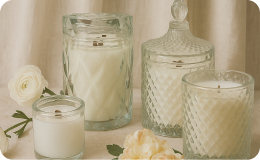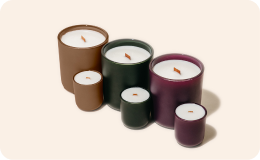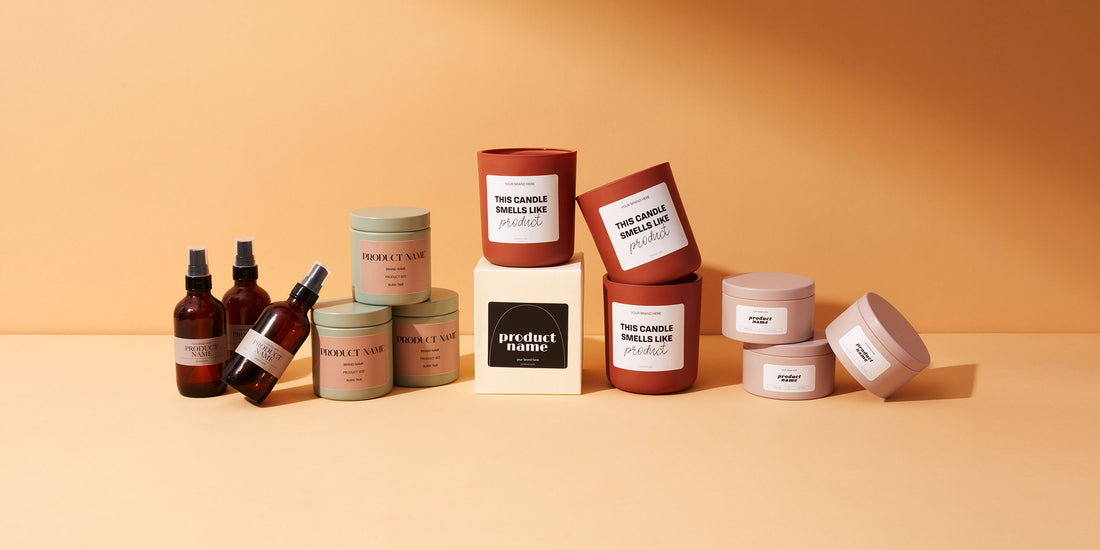Candle Label Requirements Guide
As a candle maker, your craft isn't just about creating beautiful and aromatic candles! You also want make sure your customers have a safe and enjoyable experience when burning them.
So before anyone lights the wick, each one of your candles need a proper candle label!
We'll dive into all the elements your labels need to meet the legal requirements for selling homemade candles. We've also gathered helpful tips for designing and producing them and plenty of inspiration to get your creative juices flowin'!
why is candle labeling important?
There are a few reasons it's important to properly label your candles, meeting labeling guidelines being the big one!
Your candle label serves as an essential safety measure for both you as the maker and your customers. It provides crucial information about the candle's ingredients, potential hazards, and proper usage instructions.
The label is also a large factor in the buying process! Customers will go straight to the label for fragrance and wax information. This may also be their first encounter with your brand. They could be seeing your logo, company name, and location for the first time.
The laws relating to labels and candle label requirements can be a bit complex. If you use all the guidance we've gathered here, you can rest assured your candle labels will be up to snuff!
The Fair Packaging and Labeling Act (FPLA) defines labels into three categories so let's dive in!
the outer container
Primarily used with taper candles, this is known as the "package". You can read more about outer container labels here.
We're going to focus on the other two label types in more detail. These are used more often by our makers when making container and pillar candles.

the primary label
The primary label is attached to the candle and includes vital information about your candle product. When designing this label, you'll want to adhere to the guidelines set by the Fair Label & Packaging Act.
Your label needs to include all of the following elements in a clear and concise format:
- Statement of identity: This indicates what the product is. I.e. scented candle, soy wax candle, candle.
- Candle weight: you can use ounces or grams. This should be the NET weight of your candle, not including the weight of the container.
- Company or distributor name: your legal name or the name you are doing business as.
- Location: should include, at minimum, city, state and zip code. Most businesses opt to place this on their safety label.
Not required but good practice:
- Candle wax type: virgin coconut soy wax, coco apricot cream wax, beeswax coco creme, etc.
- Burn time: the hours your candle will burn for
- How it was made: hand crafted, poured by hand, does it have a candle scent?
- Contact information: a customer service email address or phone number that customers can use to reach you

the safety label
The safety label includes hazard descriptions and instructions. It's referred to as the 'label' by ASTM International.
Every candle you make is required to have a label listing the three essential rules for candle fire safety. Most labels also include added manufacturer instructions for burning the candle properly.
The three key rules include:
- Burning within sight.
- Keep away from combustibles.
- Keep away from children.
The National Candle Association provides free downloadable pictograms of these fire safety rules available here.
If you are using a wooden wick from Makesy, you can add this warning label to your candles. It was designed for fire safety labeling and includes graphics that cover all three rules.
Safety labels should also include instructions on how to trim the wick. They should inform users to keep the candle away from foreign materials and specify the best surfaces for burning the candle. Finally, labels should indicate the maximum time the candle can burn at one time.
Now that you know how to label your candles properly, let's dive into the fun part...the design!
label materials
The National Candle Association (which helps set industry standards) recommends using biaxially oriented polypropylene (BOPP) self-adhesive labels. Unlike paper, this material is super durable and immune to temperature fluctuations. Your candle labels will be affixed to your container and near the flame. They'll need to withstand temperatures up to 1500 degrees Fahrenheit (815 degrees Celsius).
BOPP material is also stain resistant and won't react to moisture and other elements. This ensures that it will look impeccable throughout its use.
unique shapes
Lots of candle brands use a square or rectangular label which easily fits on a variety of candle jars and containers. However, if you want your candles to stand out from others, try using a unique label shape.
Circles, ovals, triangles, and long rectangles are all creative shapes that provide enough room for all of the required information. Make sure the shape you select works well with the shape of your logo. You'll want to use the space effectively so you aren't paying for more label than you need.
Here are some great examples of candles with unique label shapes that we love!
 |
 |
| wiley body | linnea candle |
 |
 |
| sensual candle co. | house of pastel design |
textures & foil
Glossy and matte are the most common paper types used for product labels, offered by almost every label printer. If you're looking for something a bit different, consider creating labels using a textured paper. This is more common among printers who offer custom options and it's a great way to add sophistication and elegance.
Fast Printing has some unique options like bark paper that gives an earthy vibe and leather that feels super luxe. Their linen, luxe kraft, and white chevron styles are also versatile choices that would pair well with a lot of aesthetics. Many of their paper stocks are recycled, FSC certified, and eco-friendly too.
Another way to add texture is with metallic foil. For a subtle touch, you could use foil in a small dose like on the logo alone. For a more glamorous look, add foil throughout your design or combine with metallic paper for the ultimate statement.
 |
 |
| jax kelly | p.f. candle co. |
design & aesthetic
Think about your brand as a whole when you go through the process of designing your candle labels. Finalize the aesthetic you're going to commit too and keep that as your north star.
Your label design should also be cohesive with other elements of your brand-- your website, business cards, and advertising. Include a few design elements that run throughout like a consistent color palette, graphic elements, and fonts.
Your customers should be able to easily recognize your brand across all of your products based on the label alone. If you also sell room sprays or diffusers, make sure your candle labels are consistent with the design.
great examples
From minimal to all out graphic, there are so many ways you can go with your design. We've gathered a ton of different designs from brands across the world to inspire you!
 |
 |
| monday moose | esselle |
 |
 |
| lark & ives | lvl collective |
 |
 |
| nail thoughts | leif shop |
eco-friendly label options
You can showcase your commitment to the environment and resonate with conscious consumers by using labels made from eco-friendly and sustainable materials.
Labels made from recycled paper use post-consumer waste or agricultural residue fibers, reducing the demand for virgin paper and minimizing the environmental impact associated with paper production.
Biodegradable labels are designed to break down naturally over time, minimizing their environmental footprint. Look for labels made from materials like biodegradable film, compostable paper, or plant-based alternatives such as sugarcane or cornstarch.
The Forest Stewardship Council (FSC) is an internationally recognized certification that ensures responsible forest management. By using FSC certified labels, you demonstrate your commitment to sourcing materials from sustainably managed forests. These labels are produced from wood fibers derived from FSC-certified forests, which support biodiversity, protect indigenous rights, and maintain the ecological balance of our planet's forests.
You can also consider using water-based inks instead of petroleum-based inks. These inks have a lower environmental impact as they contain fewer volatile organic compounds (VOCs) and produce fewer air pollutants during the printing process. Additionally, water-based inks are easier to recycle and have a reduced impact on the recycling process compared to their petroleum-based counterparts.
producing your labels
If you're using makesy vessels, don't miss our ready-to-use templates from Vistaprint. They are designed and sized to perfectly fit our aura vessels, metal tins, and tea lights.
It's easy to customize the labels with your logo, fragrance information, and other details. And because you're a makesy maker, you get special discounted pricing! Once you've designed your labels and placed your order, they arrive within 5 to 7 business days.









